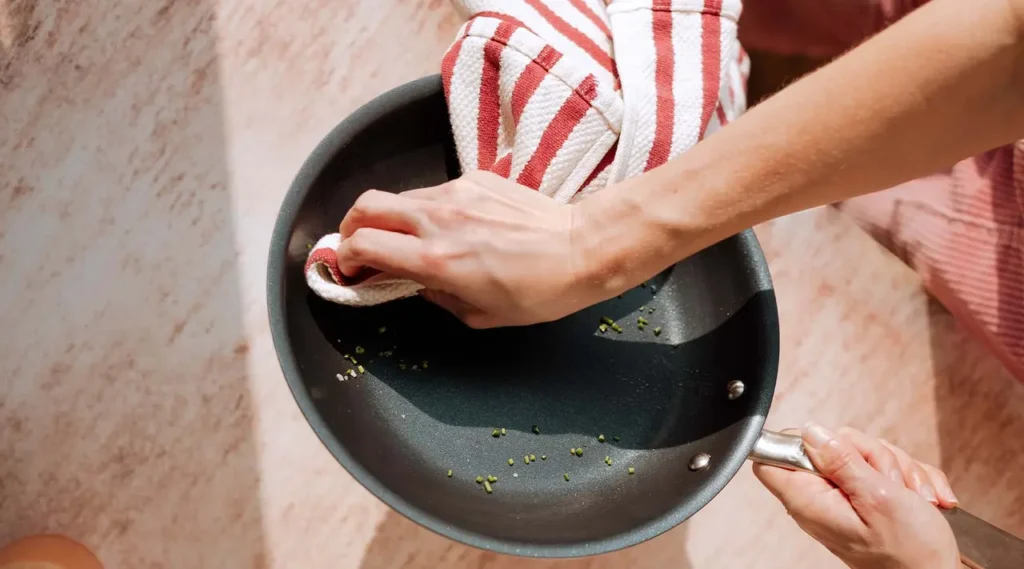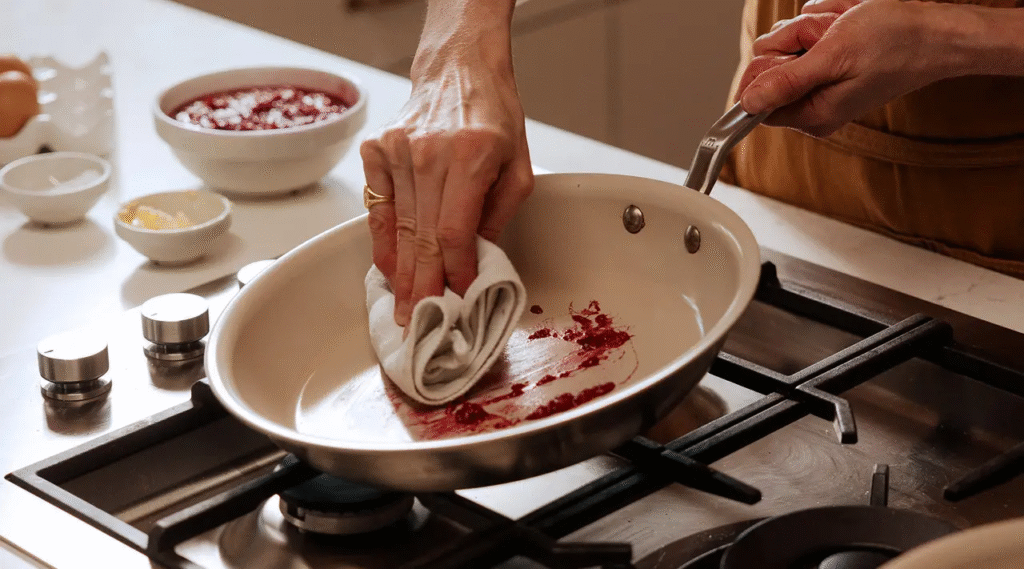How to Properly Clean a Frying Pan
Or, how to keep your tools in tip top shape.

Chances are, your frying pans see a lot of action on a regular basis. Whether you’re scrambling eggs for breakfast or searing steak for dinner, a frying pan is likely going to end up in your sink by the end of the day. To help these kitchen staples withstand daily use in the long term, it’s important to learn how to properly clean and care for it, regardless if you prefer non stick, stainless steel, ceramic, enameled cast iron, or carbon steel.
In this guide we’ll dive into the basics of each material, including how to clean it and what to avoid (primarily the dishwasher, at all costs). In general, however, skillet maintenance is light and follows a similar method across the board, regardless of construction material.
Table of Contents
- Ceramic Non Stick
- ProCoat Non Stick
- Stainless Steel
- Do You Really Need to Follow Cookware Cleaning Instructions?
- Ready to Cook?
Ceramic Non Stick
Much like other pieces of non stick cookware, our CeramiClad™ Non Stick is a breeze to both cook with and clean afterwards. The main factor to keep in mind when cleaning a ceramic pan (or any piece of non stick cookware) is to protect the coating of the pan—scrubbing too hard, running it through the dishwasher, or even scraping at some stubborn residue with a sharp-edged utensil can all permanently damage the delicate non stick coating.
How to Clean Ceramic Frying Pans
There’s truly no complicated science or method to cleaning a ceramic pan—you can even wipe it clean with a paper towel if you’re cooking something else right after. Most times, a simple rinse and wipe with a soapy dish sponge is enough to get it clean. Every so often, remember to clean the outside and bottom of the pan to keep it from getting too stained or discolored—and only clean your pan once it’s cool to the touch.
ProCoat Non Stick
Our ProCoat Non Stick Frying Pans are coated with multiple layers of a premium, professional-grade non stick coating that prevents food from sticking. This ensures an easy, seamless cleanup at the end of the night, no matter what you were cooking. Just like with ceramic, be mindful of the coating when cleaning, stacking, and cooking.
How to Clean Non Stick Frying Pans
To clean off stuck-on bits of food, rinse the pan with warm water and gently wipe its surface with dish soap and the soft side of a dish sponge. It’s important to avoid abrasive tools, like steel wool, when cleaning non stick cookware, as its surface can be easily damaged. The same goes for putting non stick in the dishwasher—we highly recommend only cleaning non stick cookware by hand.
Check out our guide for in-depth advice on cleaning non stick pans for more guidance if you come across an intensive cleaning need.
Stainless Steel
Stainless steel pans are revered by home and professional chefs alike for their incredibly durable, nonreactive surface, as they’re constructed from thin layers of premium metals and alloys optimized for efficiency and conductivity. These are “cladded” together to create a durable, unfussy cooking surface with an attractive burnished exterior.
How to Clean Stainless Steel Pans
To clean your stainless pan, start with warm, soapy water and a non-abrasive sponge. To remove burnt residue, we recommend soaking the pan in hot water before scrubbing its surface with Stainless Steel Cleaner or similar.
If you don’t have a cleaning solution formulated for stainless steel, a little more elbow grease and common kitchen tools will do the job about as well—though it’ll take more effort. A vinegar rinse will help remove rainbow discoloration, while a paste of baking soda and water helps remove stuck-on food.
Make sure to avoid abrasive cleaning tools not specifically formulated for stainless steel, such as steel wool, as they can scratch your pan’s surface. For more information on cleaning stainless steel, take a look at our guide to cleaning your stainless steel pan in 3 steps.
Do You Really Need to Follow Cookware Cleaning Instructions?

Just as we do with updated user agreements, many of us take cookware’s often-specific cleaning instructions as “something to skim.” However, to prolong the lifespan of your pan, we advise actually reading your cookware’s instructions—and following them.
If you’ve invested in premium cookware that can last decades with proper care, then you’re only doing yourself—and your wallet!—a disservice by not taking considerations with cleaning and care.
Ready to Cook?
Now that you’re an expert on cleaning a frying pan, it’s time to take stock of the pans currently in your kitchen. In need of a new one? Choose from our variety of chef- and home cook-approved materials to find the best fit.
最畅销产品
-
Stainless Clad Frying Pan Set
Price range: $59.99 through $99.99 -
10 Inch Stainless Steel Frying Pan
Original price was: $109.99.$89.99Current price is: $89.99. -
8 Inch Stainless Steel Frying Pan
Original price was: $89.99.$59.99Current price is: $59.99. -
12 Inch Stainless Steel Frying Pan
Original price was: $119.99.$99.99Current price is: $99.99. -
Professional Knife Sharpener for Kitchen
Original price was: $79.90.$69.90Current price is: $69.90.





